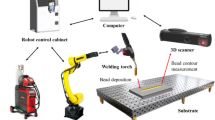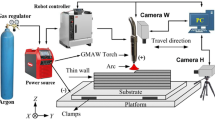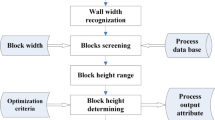Abstract
The directed energy deposition-arc (DED-arc) process is gaining popularity for cost-effective production of large parts, especially in the marine industry. However, precise shaping control, especially for parts with sharp corners, has been challenging. Nickel aluminum bronze (NAB) alloy, widely used in the marine field, is an expensive material, making it crucial to improve its forming accuracy. To tackle this challenge, the Angle-Driven Parameter Control Model (APCM) has been introduced. This model is designed to enhance corner paths in the DED-arc process for NAB alloy. By adjusting the travel speed, the APCM aims to reduce height errors at corners. To validate the effectiveness of the APCM, single bead depositions and a multi-layer thin-wall component with seven different angles (10°, 20°, 30°, 45°, 60°, 75°, and 90°) were tested. Results indicate that the APCM has a more significant optimization effect at smaller angles. For angles above 60°, relatively small height deviations can be achieved without parameter control. For the 15-layer thin-wall component, the APCM control reduced the height deviation at the 10° angle from 7.72 to 2.09 mm. Therefore, the proposed APCM is ideal for corner paths in the DED-arc process of NAB alloy.











Similar content being viewed by others
References
Armstrong M, Mehrabi H, Naveed N (2022) An overview of modern metal additive manufacturing technology. J Manuf Process 84:1001–1029. https://doi.org/10.1016/j.jmapro.2022.10.060
Cai YH, Xiong J, Chen H, Zhang GJ (2023) A review of in-situ monitoring and process control system in metal-based laser additive manufacturing. J Manuf Syst 70:309–326. https://doi.org/10.1016/j.jmsy.2023.07.018
Zhang QR, Guan YC (2023) Application of metal additive manufacturing in oral dentistry. Curr Opin Biomed Eng 25:100441. https://doi.org/10.1016/j.cobme.2022.100441
Blakey-Milner B, Gradl P, Snedden G, Brooks M, Pitot J, Lopez E, Leary M, Berto F, du Plessis A (2021) Metal additive manufacturing in aerospace: a review. Mater Design 209:110008. https://doi.org/10.1016/j.matdes.2021.110008
Schuhmann D, Rockinger C, Merkel M, Harrison DK (2022) A study on additive manufacturing for electromobility. World Electr Vehic J 13:154. https://doi.org/10.3390/wevj13080154
Ozel T, Shokri H, Loizeau R (2023) A review on wire-fed directed energy deposition based metal additive manufacturing. J Manuf Mater Proc 7:45. https://doi.org/10.3390/jmmp7010045
Greer C, Nycz A, Noakes M, Richardson B, Post B, Kurfess T, Love L (2019) Introduction to the design rules for metal big area additive manufacturing. Addit Manuf 27:159–166. https://doi.org/10.1016/j.addma.2019.02.016
Gardner L, Kyvelou P, Herbert G, Buchanan C (2020) Testing and initial verification of the world’s first metal 3d printed bridge. J Constr Steel Res 172:106233. https://doi.org/10.1016/j.jcsr.2020.106233
Yin LM, Wang JZ, Hu HQ, Han SG, Zhang YP (2019) Prediction of weld formation in 5083 aluminum alloy by twin-wire CMT welding based on deep learning. Weld World 63:947–955. https://doi.org/10.1007/s40194-019-00726-z
Xiong J, Wen CF (2023) Arc plasma, droplet, and forming behaviors in bypass wire arc-directed energy deposition. Addit Manuf 70:103558. https://doi.org/10.1016/j.addma.2023.103558
Tasdemir A, Nohut S (2021) An overview of wire arc additive manufacturing (Waam) in shipbuilding industry. Ships Offshore Struc 16:797–814. https://doi.org/10.1080/17445302.2020.1786232
Wang R, Zhang HO, Gui-Lan W, Zhao XS (2020) Cylindrical slicing and path planning of propeller in wire and arc additive manufacturing. Rapid Prototyp J 26:49–58. https://doi.org/10.1108/rpj-02-2019-0035
He TY, Yu SF, Huang AG, Yu GZ (2021) Path planning and forming of wire multi-arc additive collaborative manufacture for marine propeller bracket. J Manuf Process 68:1191–1201. https://doi.org/10.1016/j.jmapro.2021.06.028
Ding DH, Pan ZX, van Duin S, Li HJ, Shen C (2016) Fabricating superior nial bronze components through wire arc additive manufacturing. Materials 9:652. https://doi.org/10.3390/ma9080652
Sames WJ, List FA, Pannala S, Dehoff RR, Babu SS (2016) The metallurgy and processing science of metal additive manufacturing. Int Mater Rev 61:315–360. https://doi.org/10.1080/09506608.2015.1116649
Jafari D, Vaneker THJ, Gibson I (2021) Wire and arc additive manufacturing: opportunities and challenges to control the quality and accuracy of manufactured parts. Mater Design 202:109471. https://doi.org/10.1016/j.matdes.2021.109471
Petrik J, Bambach M (2023) Reinforcement learning and optimization based path planning for thin-walled structures in wire arc additive manufacturing. J Manuf Process 93:75–89. https://doi.org/10.1016/j.jmapro.2023.03.013
Han SW, Yoo H, Shin S, Kim H, Lee G, Jeon J, Han S, Cho J (2023) Parameter optimization of Waam with pulsed Gmaw for manufacturing propeller-shaped blade. Int J Precis Eng Manuf 24:1103–1110. https://doi.org/10.1007/s12541-023-00797-5
Cao Y, Zhang YC, Ming WY, He WB, Ma J (2023) Review: the metal additive-manufacturing technology of the ultrasonic-assisted wire-and-arc additive-manufacturing process. Metals 13:398. https://doi.org/10.3390/met13020398
Zahidin MR, Yusof F, Rashid SHA, Mansor S, Raja S, Jamaludin MF, Manurung YH, Adenan MS, Hussein NIS (2023) Research challenges, quality control and monitoring strategy for wire arc additive manufacturing. J Mater Res Technol 24:2769–2794. https://doi.org/10.1016/j.jmrt.2023.03.200
Novelino ALB, Carvalho GC, Ziberov M (2022) Influence of Waam-Cmt deposition parameters on wall geometry. Adv Ind Manuf Eng 5:100105. https://doi.org/10.1016/j.aime.2022.100105
Li ZH, Hou ZM, Pan ZX, Wu D, Xu J (2023) A nonautoregressive dynamic model based welding parameter planning method for varying geometry beads in Waam. IEEE Tans Ind Electron 70:2770–2779. https://doi.org/10.1109/Tie.2022.3172762
Xiong J, Zhang YY, Pi YP (2021) Control of deposition height in waam using visual inspection of previous and current layers. J Intell Manuf 32:2209–2217. https://doi.org/10.1007/s10845-020-01634-6
Lam TF, Xiong Y, Dharmawan AG, Foong S, Soh GS (2020) Adaptive process control implementation of wire arc additive manufacturing for thin-walled components with overhang features. Int J Adv Manuf Technol 108:1061–1071. https://doi.org/10.1007/s00170-019-04737-4
Zhao Y, Li F, Chen SJ, Lu ZY (2020) Direct fabrication of inclined thin-walled parts by exploiting inherent overhanging capability of Cmt process. Rapid Prototyp J 26:499–508. https://doi.org/10.1108/rpj-03-2019-0081
Gudeljevic M, Klein T (2021) Investigation of material characteristics of intersections built by wire and arc additive manufacturing using locally varying deposition parameters. Int J Adv Manuf Technol 116:2021–2029. https://doi.org/10.1007/s00170-021-07548-8
Song GH, Lee CM, Kim DH (2021) Investigation of path planning to reduce height errors of intersection parts in wire-arc additive manufacturing. Materials 14:6477. https://doi.org/10.3390/ma14216477
Li F, Chen SJ, Wu ZY, Yan ZH (2018) Adaptive process control of wire and arc additive manufacturing for fabricating complex-shaped components. Int J Adv Manuf Technol 96:871–879. https://doi.org/10.1007/s00170-018-1590-0
Woo YY, Han SW, Oh IY, Moon YH, Ha W (2019) Control of directed energy deposition process to obtain equal-height rectangular corner. Int J Precis Eng Manuf 20:2129–2139. https://doi.org/10.1007/s12541-019-00226-6
Ding DH, Zhao RZ, Lu QH, Pan ZX, Li HJ, Wang K, He KF (2021) A shape control strategy for wire arc additive manufacturing of thin-walled aluminium structures with sharp corners. J Manuf Process 64:253–264. https://doi.org/10.1016/j.jmapro.2021.01.029
Yu YS, Xiong J, Chen Y, Zhao HH (2023) Process stability control of corner structures in robotic gas tungsten arc additive manufacturing via arc sensing. J Manuf Process 101:156–170. https://doi.org/10.1016/j.jmapro.2023.05.076
Dharmendra C, Rice KP, Amirkhiz BS, Mohammadi M (2021) Atom probe tomography study of kappa-phases in additively manufactured nickel aluminum bronze in as-built and heat-treated conditions. Mater Design 202:109541. https://doi.org/10.1016/j.matdes.2021.109541
Shen C, Pan ZX, Ding DH, Yuan L, Nie N, Wang Y, Luo DZ, Cuiuri D, van Duin S, Li HJ (2018) The influence of post-production heat treatment on the multi-directional properties of nickel-aluminum bronze alloy fabricated using wire-arc additive manufacturing process. Addit Manuf 23:411–421. https://doi.org/10.1016/j.addma.2018.08.008
Cho WI, Na SJ (2021) Impact of driving forces on molten pool in gas metal arc welding. Weld World 65:1735–1747. https://doi.org/10.1007/s40194-021-01138-8
Xiong J, Zhang GJ, Gao HM, Wu L (2013) Modeling of bead section profile and overlapping beads with experimental validation for robotic Gmaw-based rapid manufacturing. Robot Cim-int Manuf 29:417–423. https://doi.org/10.1016/j.rcim.2012.09.011
Ding DH, Pan ZX, Cuiuri D, Li HJ (2015) A multi-bead overlapping model for robotic wire and arc additive manufacturing (Waam). Robot Cim-int Manuf 31:101–110. https://doi.org/10.1016/j.rcim.2014.08.008
Li YZ, Sun YF, Han QL, Zhang GJ, Horvath I (2018) Enhanced beads overlapping model for wire and arc additive manufacturing of multi-layer multi-bead metallic parts. J Mater Process Technol 252:838–848. https://doi.org/10.1016/j.jmatprotec.2017.10.017
Funding
This work is supported by “Deep Blue Project” Fund of Shanghai Jiao Tong University (No. WH410260401/027), the Fundamental Research Funds for the Central Universities and Institute of Marine Equipment, National Natural Science Foundation of China (NSFC, No. U1937601), and Shanghai Rising-Star Program of Science and Technology Commission of Shanghai Municipality (STCSM, No. 23QA1404700).
Author information
Authors and Affiliations
Contributions
All authors contributed to the study conception and design. Material preparation, data collection, and analysis were performed by Jiacheng Huang. The first draft of the manuscript was written by Jiacheng Huang, and all authors commented on previous versions of the manuscript. All authors read and approved the final manuscript.
Corresponding author
Ethics declarations
Competing interests
The authors declare no competing interests.
Additional information
Publisher’s Note
Springer Nature remains neutral with regard to jurisdictional claims in published maps and institutional affiliations.
Rights and permissions
Springer Nature or its licensor (e.g. a society or other partner) holds exclusive rights to this article under a publishing agreement with the author(s) or other rightsholder(s); author self-archiving of the accepted manuscript version of this article is solely governed by the terms of such publishing agreement and applicable law.
About this article
Cite this article
Huang, J., Li, F., Shen, C. et al. An angle-driven parameter control model for corner paths in the DED-arc process of nickel aluminum bronze alloy. Int J Adv Manuf Technol 130, 5285–5298 (2024). https://doi.org/10.1007/s00170-024-12963-8
Received:
Accepted:
Published:
Issue Date:
DOI: https://doi.org/10.1007/s00170-024-12963-8




